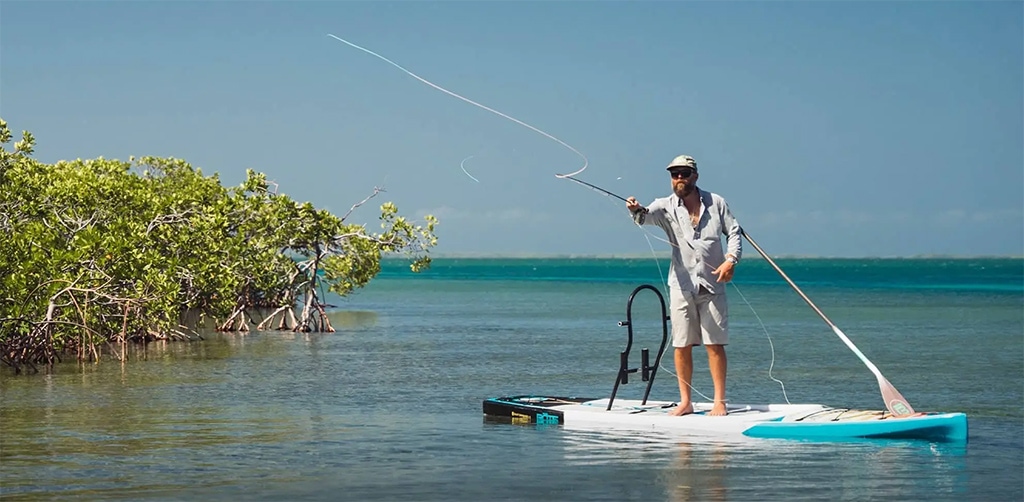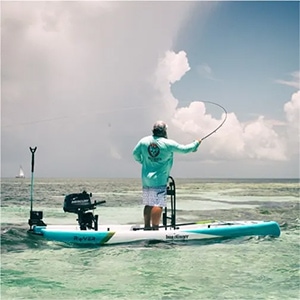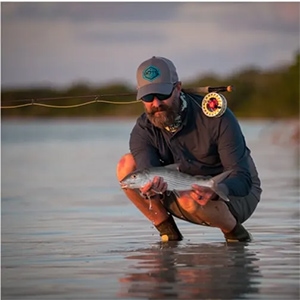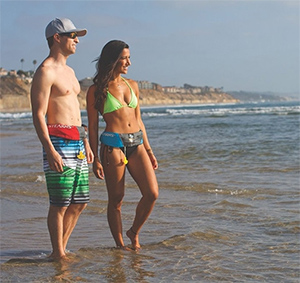If you’re a fly angler looking to try paddle boarding or a SUPer who is curious about fly fishing, you’ve stumbled upon the right post. Fly fishing and SUP are both beautiful sports that engage not just your muscles but your mind as well.
Combining the two activities sounds fun but a little tricky, especially as far as the stability of a stand up paddle board is concerned. A lot could go wrong and that includes losing your precious fly fishing gear.
SUP fly fishing, however, isn’t that hard. You just need the right fly fishing stand up paddle board, your fishing gear, and a little bit of practice.
Key Takeaways
- Fly fishing and SUP are both engaging sports that can be combined for a fun and relaxing experience.
- Choosing the right fly fishing stand up paddle board is important and depends on factors such as size, design, stability, weight capacity, and material.
- A basic setup for SUP fly fishing includes a fishing rack, an anchor, a cooler, a waterproof bag, and essential fly fishing gear.
- SUP fly fishing has many advantages over other fishing methods, such as stealth, visibility, portability, and health benefits.
- Stay safe while SUP fly fishing by wearing a PFD and leash, informing others of your location, and keeping your deck neat.
Choosing the Best Fly Fishing Paddle Board
This is an important decision because the wrong fishing paddle board can ruin your fishing experience. Different SUP types are designed for different SUP activities, so you want to focus on SUP fishing boards.
They are made for anglers and come with all the features you may need. But even the fishing paddle boards vary when it comes to size and design.
So here are the factors you should consider when making your decision.
a. Inflatable Paddle Board Vs Hard Paddle Board
Some anglers swear by inflatable boards while others say that hard SUPs are the best. It’s a matter of lifestyle and personal preference.
An inflatable paddle board is lightweight and can be folded into a smaller package once deflated. It would be ideal for you if you don’t have a lot of storage space. It is also easy to transport and you can travel anywhere with it to find the best fishing spots.
Many people are surprised when they find out how tough inflatable stand up paddle boards are. These boards are built using military-grade PVC, making them extremely durable. They don’t dent as easily as most solid SUPs.
Their main downside is performance. Inflatable boards are quite rigid when fully inflated and glide well, just not as well as hard SUPs. They can also be hard to inflate with a hand pump.
You should consider a solid paddle board if you have a car roof rack for transporting it and don’t mind the board taking up a lot of storage space. Fishing SUPs aren’t small so traveling with a hard SUP to and from the fishing location won’t be fun.
The best thing about solid paddle boards is their performance, especially if you get one with a displacement hull. Their tracking is smooth and impressive, perfect for sneaking up on your prey.
Epoxy boards also don’t require inflating and deflating.
b. Stability
More than anything, you need a stable board to fly fish if you want to have an amazing experience. Casting and fighting fish involves a lot of movement and you can easily end up taking an unplanned swim. A stable paddle board allows you to move freely without losing your balance.
Width is a key factor in determining a SUP’s stability and this explains why fishing boards are wide. So the wider, the better—anything from 35 inches wide will be great. Note that the width also affects speed. Wide paddle boards face more resistance and are, thus, slower. Keep that in mind.
Some fishing paddle boards, like the Bote Rover micro skiffs, have a recessed deck to make them even more stable.
The length of a standup paddle board also plays a part. A long and wide SUP will have a large platform that is stable and perfect for fly fishing. Just know that a bigger paddle board will be heavier and harder to carry around.
c. Weight Capacity
You don’t need a lot of gear for fly fishing. But the weight of your rod holders, tackle box, SUP cooler, trolling motor and other fishing gear can add up and weigh the SUP down.
When you load more than your paddle board can handle, it performs poorly and you’ll have a hard time trying to control it.
Every paddle board has a set weight limit. Make sure the fishing SUP you get can hold you and everything you plan on bringing to your fishing trip. Don’t forget your passengers, maybe a dog, child, or fishing buddy.
The total weight should be around 50 pounds less than the given weight limit.
d. Fishing Gear Compatibility
Fishing SUP boards come in many different designs. Some have a simple design, allowing you to bring basic fishing equipment. Others have advanced designs, like some Bote boards, and are compatible with all sorts of fishing gear.
The good thing about SUP fly fishing is that it doesn’t have to be complicated. If you want a simple setup, you’ll be happy with a basic fishing paddle board. It will come with gear mounts for a rod holder, tackle rack, and maybe a paddle holder. It will also have bungee cord storage for a dry bag as well as extra D-rings.
If you want the ultimate SUP fishing setup, find a fishing SUP that is compatible with many different accessories, such as the Bote micro skiff. It is equipped with multiple rack receivers, a motor rack, attachment plugs, fishing rod holes in the deck, and more.
Consider your ideal setup and find a SUP that is compatible with your gear so you don’t have to try any DIY ideas (which will void your warranty).
SUP Fly Fishing Setup
Everyone knows that you need a paddle board and a paddle for SUP fly fishing. But where do you go from that? Here are a few essentials for a basic setup.
1. Tackle Rack
I’d say that a fishing rack is a key piece of equipment for SUP anglers. It will hold your fly rod, a backpack or tackle bag, a fish finder, action camera, and other small fishing accessories. The best thing about SUP fishing racks is that they don’t take up much space—which is awesome because you don’t have a lot of space on a paddle board.
2. Anchor and Sand Spear
You need an anchor to keep your paddle board in place when casting. Fighting a big fish from an unanchored SUP is not something you want, especially if you didn’t plan on taking a swim.
Having your paddle board stable and in place gives you an advantage. Besides, SUP anchors are small and easy to use.
If you’re sight fishing in shallow water, a sand spear will do.
3. SUP Cooler
You’ll need a cold drink after you’ve been out fly fishing in the sun for hours. You can sit back, relax, and enjoy a refreshing drink as you take in the scenery before you resume fishing.
You also need a place to store your fish and keep them fresh.
Other than keeping your drinks cold and your catch fresh, a cooler also acts as a seat. SUP boards don’t come with seats and you can get fatigued after being on your feet for a long time.
4. Small Waterproof Bag
One thing about paddle boarding is that you can expect water to splash on everything. SUPs don’t have an enclosed deck and your things are exposed.
A small waterproof bag for your valuables will ensure that they stay dry. It’s even better if you get a waist pouch because you’ll be able to access them easily.
5. Fly Fishing Gear
Lastly, you need your fly fishing gear. When it comes to SUP fishing, less is more. Only bring what you’re absolutely sure you’ll use. The basics include the essentials discussed above, fly rods, fly box, fly line, and anything else you consider a necessity.
ALSO READ: Should You Consider the Sea Eagle Fishsup for SUP Fly Fishing?
The Benefits of Fly Fishing from a Paddle Board
Why would someone use a paddle board for fly fishing instead of, say, a kayak or canoe?
a. Paddle Boards Are Quiet
SUPs are unbeatable when it comes to stealth.
If you want to silently sneak up on fish and land a big catch, a paddle board is your best option. Paddle boards move smoothly and quietly on the water; you won’t have to worry about scaring fish away.
b. Better Visibility
Another advantage of SUP fishing is that, unlike in a kayak, you don’t sit. Standing gives you a wide field of view. You can see farther and better, a factor that increases your chances of catching something.
ALSO READ: SUP Fishing Vs Fishing From A Kayak
c. Great Workout
Stand up paddle boarding is a full-body workout that engages almost every muscle group. It also relaxes your mind. Some people have said that fly fishing is like meditation to them. Combining the two gives you the ultimate exercise that improves your physical, mental and even spiritual health.
d. SUPs Are Not Bulky
Transporting a canoe or kayak is anything but easy because they are big and heavy. SUPs are smaller and lighter, plus, you can choose an inflatable SUP board which is even easier to carry around.
Paddle boards are ideal, especially when going on a solo fishing trip and you’re forced to carry the SUP at some point.
4 Useful Paddle Board Fly Fishing Tips
SUP fly fishing can be intimidating for first-timers. Check out the following tips for a fun and safe experience.
1. Safety First!
Paddle boarding is a safe activity but there are risks involved when it comes to water activities.
Always wear your PFD and leash when paddle board fishing. The leash ensures that you don’t lose your SUP when you fall in, especially on a windy day. If you have your board you’ll be able to stay afloat and paddle to safety.
A PFD or personal floatation device keeps you from drowning. Most SUP fly anglers may not want to wear one because it is uncomfortable. However, you can wear a belt or harness PFD that won’t get in the way.
Let your loved ones know where you’ll be, and have a reliable means of communication. For the first few trips, it’s better to go with friends.
2. Keep It Simple
Many pro SUP fishermen will tell you that less is more. Don’t bring every single piece of fishing equipment you own on your fishing trip. A paddle board doesn’t have that much space and you also don’t want to exceed the weight limit.
Have a basic setup with only the necessary fishing gear.
ALSO READ: 15 Paddle Board Fishing Tips You Need To Know
3. Clear the Deck
Keep your deck neat to prevent your fly line from catching your stuff. Hang a small bag or mesh pocket on the tackle rack to put small stuff so they are not lying around on the deck.
4. Be Ready to Cast
Don’t wait until you spot fish to start preparing your rod for casting. Ensure the rod is ready, the line is neatly lying on the deck, and the fly is within reach.
YOU MAY ALSO LIKE: How to attach a fish finder to your SUP board.
Paddle Board Fly Fishing FAQs
Can You Fly Fish from a Paddle Board?
Yes, you can fly fish from a paddle board. Anglers love using SUP boards because of visibility and the fact that it is easier to sneak up on fish. Paddle boarding is also a nice full-body workout—so that’s an awesome bonus.
What Time of Year Is Best for Fly Fishing?
You can go fly fishing all year round. Most people prefer to fly fish during summer, which is the warmest season. It all depends on your style and the species of fish you’re looking for.
How Do You Rig a Fishing SUP?
As mentioned, you’ll want to keep your SUP fly fishing setup simple. Here is a good example of how to rig your fishing SUP.
Final Thoughts
Fly fishing from a paddle board is a whole lot of fun.
But first, you’ll need a proper SUP for fishing—one that is stable with a high enough weight capacity. You also have to get a few essentials for convenience and safety as well as your fly fishing gear. And that’s it!
Make sure you take all the necessary safety precautions. Wear your PFD and leash at all times and let your loved ones know where you will be.
Finally, don’t forget to enjoy the experience!




